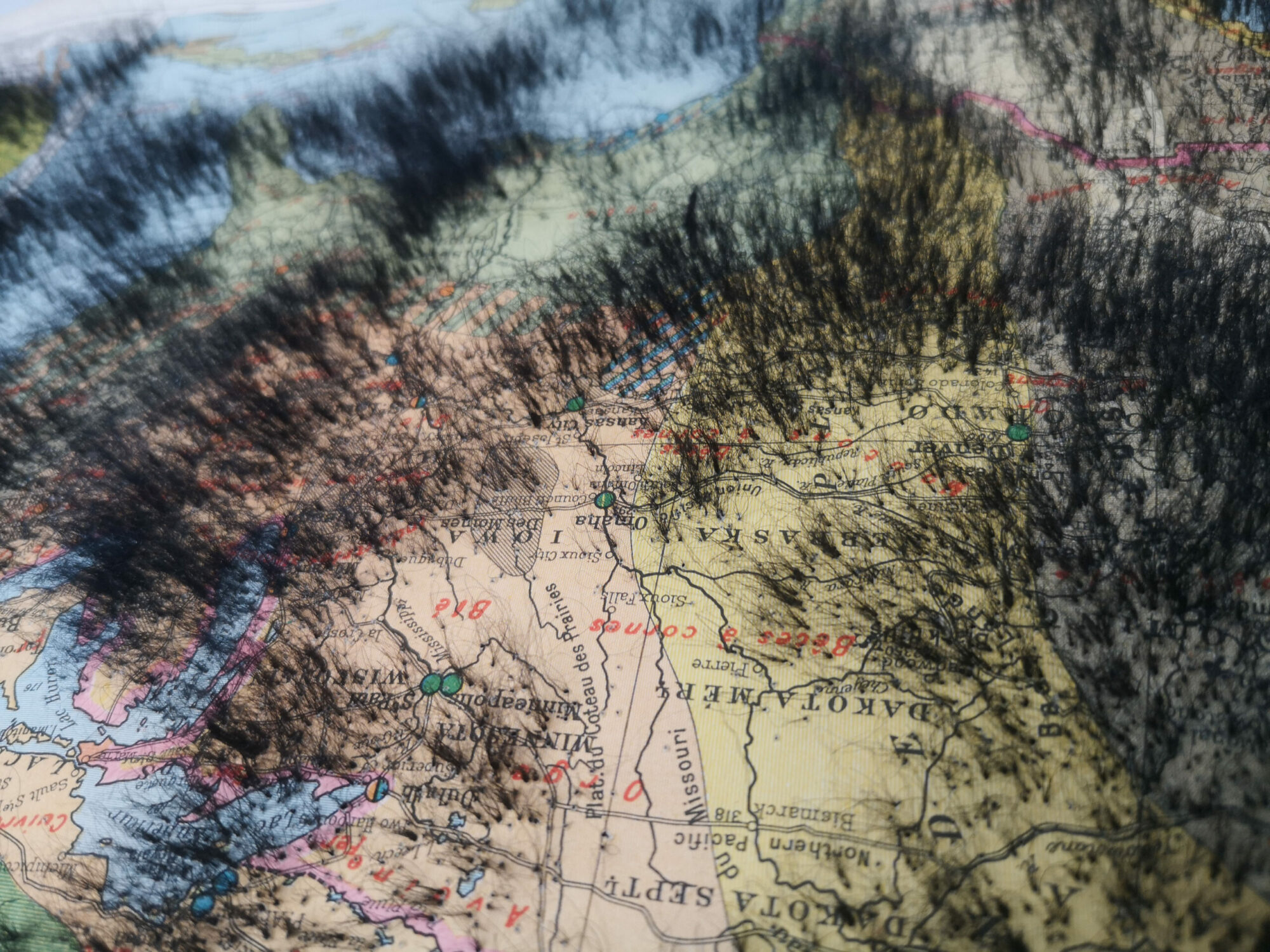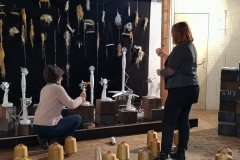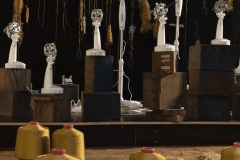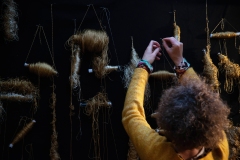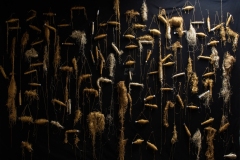Impossibles Réparations
Impossible Reparations
This project is divided into three parts:
1-Extraction/The pillaging
2-Reparation/Unravelling the knots
3-Reconstructing/Retraming history
This is a performance that uses simple mechanisms to dramatise the history of colonisation, or how the Western world enriched and built itself by exploiting and plundering the colonised countries, only to lose ground without being able to repair all the damage caused.
Using a metaphorical approach that questions the possibility of colonial reparation to match the actual damage caused, this project highlights the difficulty of reversing the process and healing the wounds. It is not, then, the political, economic and symbolic necessities of reparations that the artist is criticising here, but rather the irreversibility of the violence inflicted.
Part1 – Extraction/Looting
The fans represent the colonising countries and are symbols of a new, mechanical era, the image of a certain progress exported by the West to the colonised countries. The cones of golden thread are the resources and raw materials of the colonised countries. The images of the populations, fauna and flora of the exploited countries become the supports/cans that disappear beneath the spoils of the West, which are wound up and exposed as the process unfolds.
The cans of golden thread are the accumulated spoils of resource extraction and are pinned to the wall like trophies. The blocks of azobe wood allow the colonising countries to rise economically in line with the accumulated booty.
The installation is performative, participatory and evolving. The viewer, whether unwillingly or not, becomes an actor in this orchestrated plundering, reminding them that the Western society in which they live was built on these unhealthy foundations.
How the process works
Take 2 A4 sheets of printed images representing everything that the coloniser has destroyed in his path to achieve his ends, and use them as a support for the extraction. The 2 sheets are folded into quarters, then rolled to the diameter of the fan shaft and taped with black or white tape.
Once the « bobbin » support is in place, you can unroll the thread, i.e. extract the bobbin, to make up the loot by switching on the fan. Once the bobbin is full, you can hang it on the black wall fabric using a pin. You can make up as many cans as you like. Each cone is made up of a variable number of cans.
Part2 – Undoing the knots
After Extraction/Looting in the first Impossible Repairs section, it’s time to turn back the clock and try Undoing the Knots… The second chapter of this project about colonial reparation involves visitors in the difficulty and impossibility of undoing or repairing the acts of pillage committed, without perceiving the damage and rediscovering the traces and scars left behind.
The participants try to carry out the gestures of a reparation that is common to all, but also specific to each individual. The installation of the second part takes up the essential elements of the first part, i.e. :
-the loot collected during the plundering: extraction of raw materials from colonised countries, formalised by the accumulation of coils of gold thread on the wall. The reels were made from forgotten images of the fauna, flora and populations of the colonised countries that disappeared under the pillage.
-the colonising countries, who are the fans -the economy and its power, the accumulation of wealth symbolised by the blocks of azobe wood -the coffee beans that littered the floor and were trampled underfoot during the pillage -the visitors, who are the actors in the thread of history. Then there are the forged nails as a means of unravelling and repairing. They serve as a receptacle for the golden threads that will then be planted in the funerary monument designed to house this attempt at repair.
How the process works
Take a spool of golden threads pinned to the western wall. Place your spool on the axis of rotation of one of the unplugged colonial country fans. Then delicately, with full awareness of your gesture, undo the spool and the knots. Wrap the thread around one or more nails to gradually release the paper support from the spool. When the support of the reel is completely hollowed out, gently remove the tape and unfold the images of fauna, flora and populations that have been hidden under the plunder. Display the revealed images and their constituted offerings on the cenotaph.
Part3: Retraming the story
In this third chapter, the coiled nails, symbols of offerings to the images of what was ousted under the plunder, are now pillars for future reorganisation. The unravelled threads of history become warp threads, forming a common weave of reflection based on the azobe blocks, symbols of the economy and its impact on people and society.
Each participant weaves together the constructions of the deconstructions, trying to construct new reorganisations. The scraps, remnants, traces and residues of the looting and dismantling that are brought to the foot of the cenotaph now serve to weave a new common fabric, a history to be woven together.
How the process unfolds
The threads stretched between the 2 azobe columns, known as the warp threads, are the support that allows the visitor to weave. The weft threads, which are the scraps of thread found at the foot of the funerary monument, pass into the warp. Even threads, odd threads or vice versa and so on. A canvas is thus woven.
When you start weaving again after another person, look carefully to see if it is an even or odd line to ensure the transition.
